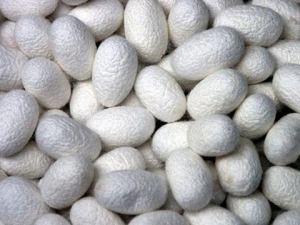The silk filaments are glued together by sericin, which is secreted by two other glands. The double silk filament on the cocoon is known as a bave, and each single filament is called a brin. The cocoon is loosened by immersion in warm water and reeling off the softened filament(s).
Silk used for clothing is generally warmer than cotton.
See also doupion silk, filoselle, floss silk, sleave silk, tussah silk, wild silk
Sources:
- BURNHAM, Dorothy (1980). Warp and Weft: A Textile Terminology, Toronto: Royal Ontario Museum, p. 123.
- TORTORA, Phyllis G. and Ingrid JOHNSON (2014). The Fairchild Books: Dictionary of Textiles, 8th edition, London: Bloomsbury, pp. 560-561.
- WOODWARD WENDELKEN, Rebecca (2012). 'Silk: cultivation of silk', in: Gale Owen-Crocker, Elizabeth Coatsworth and Maria Hayward (eds.), Encyclopedia of Medieval Dress and Textiles of the British Isles, 450-1450. Leiden: Brill 2012, pp. 515-517.
Digital source of illustration (retrieved 27 June 2016).
GVE

